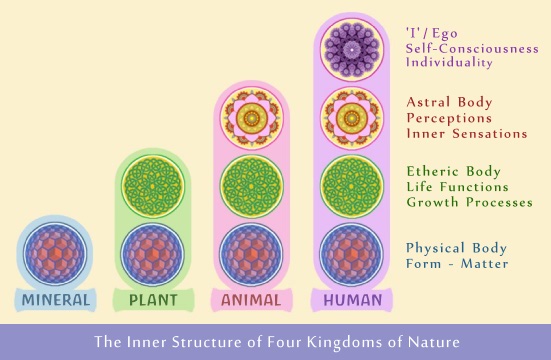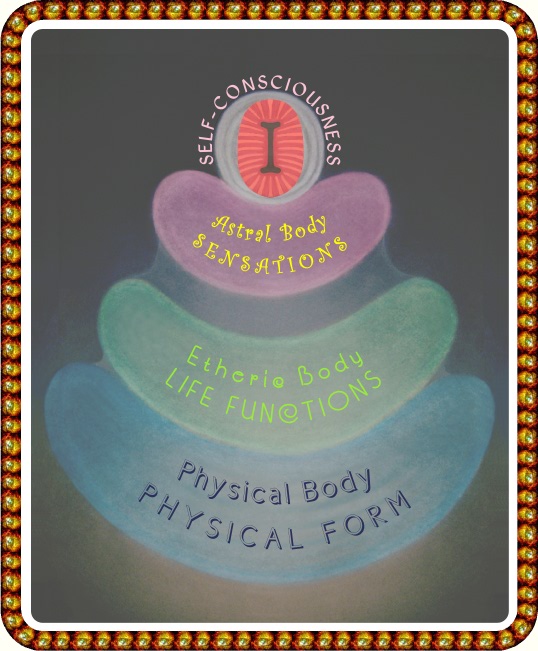Four Bodies of Man in Relation to Four Kingdoms of Nature
“Man must be regarded as a being who consists not only of the
physical body that is visible to the eye, but also of higher members – invisible
bodies. The first invisible member, the ether body, is a much finer, more
delicate body and cannot be perceived by the ordinary senses. It is the source of life not only in man,
but also in the plants and animals. Another higher member is the astral body
which enables man to have feelings and perceptions. He has this body in common with the animals, for they too have
an astral body. But man has something which the animal has not, namely,
self-consciousness, ‘I’-consciousness. Man, then, consists of the visible
physical body and of three higher members: ether body, astral body and the ‘I’.” [1]
“We learn about the human body by means of our bodily senses, and
our mode of observation can be no different than if we were learning
about other sense-perceptible things. We can observe the human being in
the same way that we observe minerals, plants and animals, and as human
beings, we are related to these three other forms of existence. Like the
minerals, we build up our bodies out of natural substances; like the
plants, we grow and reproduce; like the
animals, we perceive the
objects around us and develop inner experiences based on the impressions
they make on us. [2] Therefore, we may attribute a mineral, a plant and an
animal existence to the human being.
The structural differences between minerals, plants and animals
correspond to their three modes of existence. Just as we attribute
mineral, plant and animal modes of existence to the human body, we must
also attribute to it a fourth and distinctively
human mode. Through the
mineral mode of existence we are related to everything visible,
through the plant-like mode to everything that grows and reproduces, and
through the animal mode to all creatures that perceive their
environment and have inner experiences based on outer impressions. But
through the human mode, even with regard to the physical body, we make
up a kingdom that is ours alone.” [3]

“Spiritual science reviews four basic phenomena which we can all
recognize: form, life, sentience (a consciousness based on sense-experience)
and selfhood (an awareness of the self). We may say:
- form we share with mineral, plant, and animal;
- life we share with plant and animal;
- sensory experience we share with the animal (instincts, desires, joy and pain, etc);
- thinking, that is, a reflective consciousness, an inborn
sense of self or the ‘I am’ is something that we human beings alone, in the world of
nature, possess.” [4]
“Within the manifest world it is the physical
body in which man is of like nature with the mineral creation. Anything that distinguishes
man from the mineral cannot properly be regarded as ‘physical body’. To
clear and open-minded reflection the important fact will be that death
lays bare the part of the human being which – after death – is of like
nature with the mineral world. We can point to the corpse as to that
part of man, which, after death, is subject to processes such as are
also found in the mineral kingdom. While the same substances and forces
are indeed at work in the physical body of man and in the mineral,
during man’s life their activity is made to serve a higher function. It
is only when death has taken place that they work identically with the
mineral world. Then they appear, as indeed they must in accordance with
their own nature, as the destroyer of the form and structure of man’s
physical body.
Thus we are able clearly to distinguish what is manifest from what
is hidden in the human being. Throughout the life of man something that
is hidden must perpetually be battling with the mineral substances and
forces in the physical body. The moment the battle ceases, the mineral
form of activity makes its appearance. Although the hidden something which battles against the
disintegration of the physical body can be observed by seership alone,
in its effects it is plainly evident even to the kind of judgment which
is restricted to the outwardly manifest. For its effects are expressed
in the form and shape into which the substances and forces of the
physical body are combined during life. When death has taken place, this
form gradually disappears and the physical body becomes part of the
mineral kingdom pure and simple. Supersensible perception can observe,
as an independent member of the human being, what it is that prevents
the physical substances and forces during life from going their own way,
which would, as we have seen, lead to the disintegration of the physical
body. We will call this independent member of man’s being the
etheric body or life
body.
The etheric body then, constitutes a second member of the human
being. For supersensible perception it has indeed a higher degree of
reality than the physical. The etheric body completely permeates the
physical, of which it may be regarded as a kind of architect. All the
organs of the physical body are maintained in their form and structure
by the currents and movements of the etheric body. Underlying the
physical heart there is an etheric heart, underlying the physical brain
an etheric brain, and so on. The etheric body is in effect a
differentiated body like the physical, only far more complicated. And
whereas in the physical body there are relatively separated parts, in
the etheric all is in living interflow and movement. Man has the etheric
body in common with the plant world, just as he has the physical body in
common with the mineral. Everything that is alive has an etheric body.
From the etheric body, the science of the supersensible advances to
a further member of human nature - the astral body. And as in leading up
to the etheric body attention had to be drawn to death, so, to form a
conception of this further member of man’s nature, supersensible science
points to the phenomenon of sleep. All the creative work of man depends
– so far as the manifest world is concerned – on his activity in waking
life. But this activity is only possible if he again and again derives
from sleep a strengthening of his exhausted forces. In sleep, action and
thought disappear; pain and joy vanish from conscious life. On
awakening, man’s conscious powers well up from the unconsciousness of
sleep as if from mysterious and hidden springs. It is the same
consciousness which sinks into dark depths when man falls asleep, and
then arises again when he awakens. To the science of the supersensible,
what rouses life again and again from the unconscious state is the
astral body.
As the physical body cannot maintain its form through the mineral
substances and forces it contains, but needs to be permeated by the
etheric body, so too the forces of the etheric body cannot of themselves
become illumined with the light of consciousness. Left to itself, an
etheric body would of necessity be in a perpetual state of sleep – or,
we may also say, could only maintain in the physical body a vegetable
form of life. An etheric body that is awake is illumined by an astral
body. For outer observation the effect of the astral body disappears
when man falls asleep. For supersensible observation however, the astral
body still remains, but it is now seen to be separated from the etheric
body, or lifted out of it. Man has his physical body in common with the minerals and his
etheric body with the plants. In the same sense he is of like nature
with the animals in respect of the astral body. The plant is in a
perpetual state of sleep. Consciousness is only there when for example,
through the effect of heat, the being inwardly experiences pain.
The fourth member which supersensible science attributes to the human
being is the ‘I’
or
ego of man. If the astral body were left to
itself, pleasure and pain, feelings of hunger or of thirst would come and go
in it, but one thing would never come about – namely, the sense of something
permanent in all these things. Not the permanent itself, but that which has
conscious experience of the permanent, is here called the ‘I’. With the
awareness of something permanent and lasting in the changing flow of inner
experiences, the feeling of ‘I’, of inner selfhood begins to dawn. The mere
fact that a creature experiences hunger, for example, cannot give it the
feeling of ‘I’. On every new occasion when the causes of hunger make
themselves felt, hunger arises. The creature falls upon its food simply
because the causes of hunger are there anew. The feeling of ‘I’ comes in
when the creature is not merely impelled to take food by the renewed causes
of hunger, but when a previous satisfaction (of hunger) gave rise to a sense
of pleasure and the consciousness of the pleasure has remained (in the
memory). Here it is not only the present experience of hunger but the past
experience of satisfaction (of hunger with food) which provides the impulse
(for its repetition).
The physical body disintegrates when it is not held together by the
etheric; the etheric body falls into unconsciousness when it is not
irradiated by the astral body. In like manner the astral body would ever
and again have to let the past sink into oblivion, if the ‘I’ did not
preserve the past and carry it over into the present. Forgetting is for
the astral body what death is for the physical body and sleep for the
etheric. Or, as we may also express it:
- life is proper to the ethericbody
- consciousness to the astral body
- and memory to the ego.”
[5]
Here we need to clarify one seeming contradiction. Although the
physical body provides the outwardly perceptible physical forms of
minerals, plants, animals and human beings, this doesn’t mean that the
physical body is the sole ‘architect’ of these physical forms. This is
true only for the pure mineral bodies. In the case of living organisms,
the etheric body contributes the etheric archetypes of the forms of the
diverse living creatures. In the case of the animals and human beings,
the astral body significantly contributes to the shapes of their bodies.
And in the case of human beings the ego is the leading ‘architect’ of
the human form.
This explains why the physical body – in spite of the fact that it is
the source of our visible physical body – is the source of
disintegration of this same body after the death. As is known from
physics the mineral kingdom is heading towards so-called ‘warmth-death’,
caused by the law of entropy which causes all physical energies to
slowly disperse towards the uniform state of warmth. There is also the
recognition that the living organisms combat this tendency of
disintegration with the help of an organizing force, called ‘negative
entropy’. This organising force is the outcome of the presence of the
etheric body. Thus we have the mineral world with its substances that
give us the visible physical form, but the power of preservation of this
form comes from the etheric body. For that reason it is also called the
life body.



